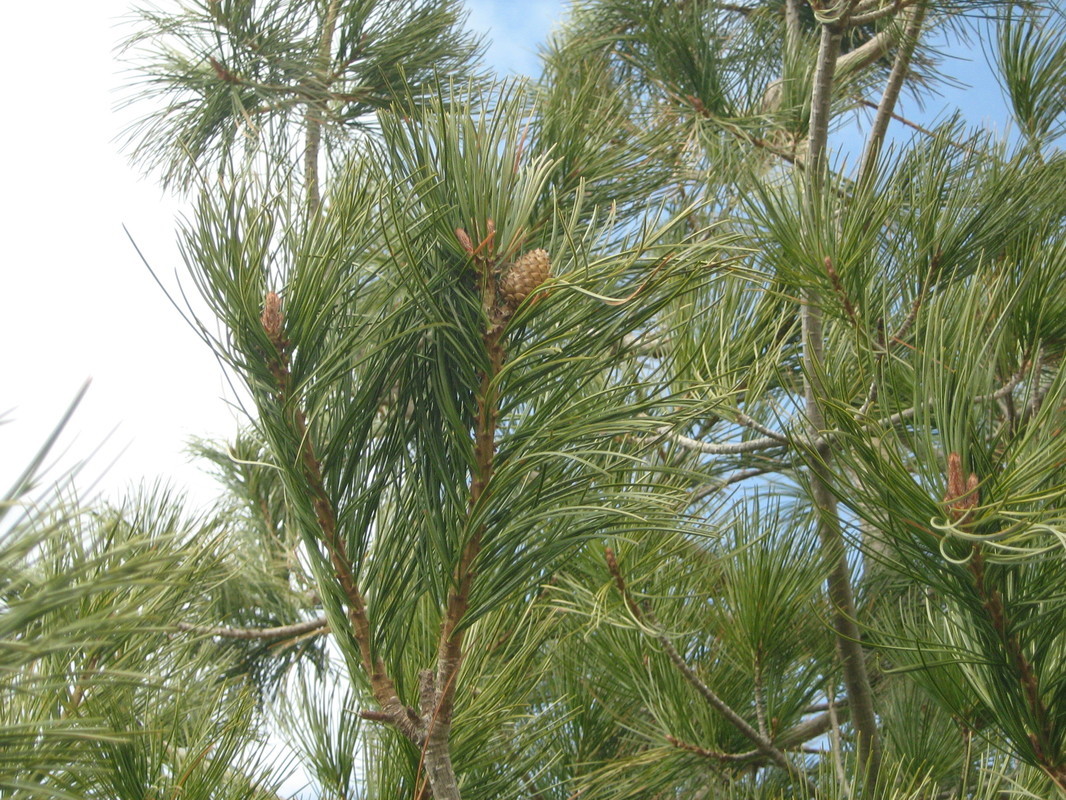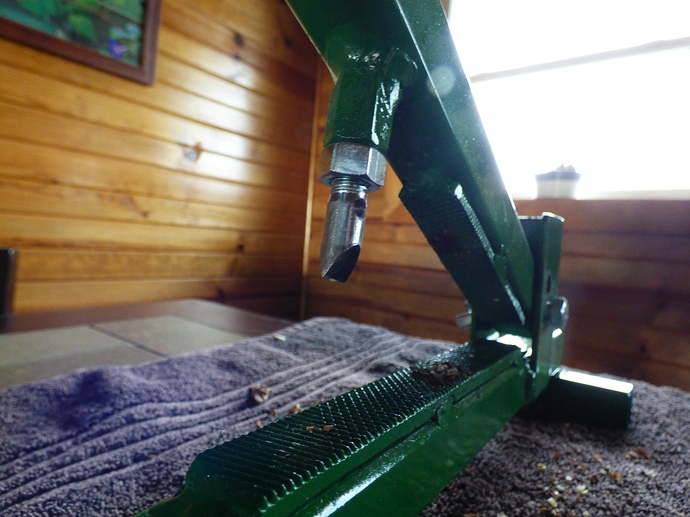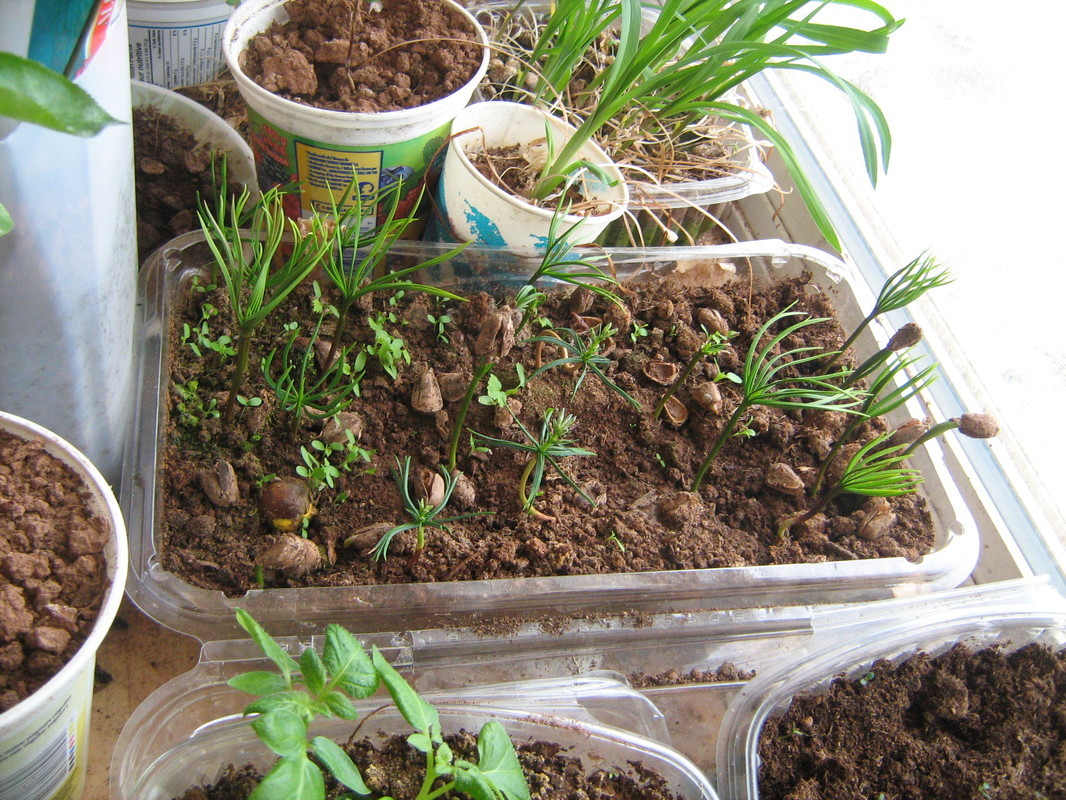Here is a first year cone, they take 2 years. Nuts (seeds) can be planted shallowly in soil from under a pine tree and left in an unheated porch or even the fridge to stratify. They need about 4 months. You are right, they are just barely self fertile, meaning for all practical purposes, you need two. Seeds in the fridge that are not damp will not have stratified yet. So fill a margerine tub with soil, plant the seeds you have and put the lid on and pop them back in the fridge. Soil from under a pine hurries them along, but you can get some in the spring when you won’t need a jackhammer.
@Maine, I’m glad to help.
My father told me all my years growing up that if I listened to him on certain topics - mistakes he had made - that I wouldn’t need to repeat them. That said, I know an old timer that has grown literally every hickory there is. I kept extensive notes from telephone calls with him. His name is Fred Blankenship (and) he builds those Mr. Hickory crackers. He doesn’t have an email address and doesn’t have a smart phone. The only way to get one of those crackers is to call him. He builds them one at a time in either John Deere green or IH Case red. These are my notes from our phone calls:
Fred Blankenship said if he could redo his orchard today (2015 phone conversation) he would grow Gary Fernald’s unknown hican from Howard McDaniel; ‘Grimo-5’ shagbark; and shagbark ‘Grainger’. Fred stated that ‘Grainger’ had hardly any (parts of the inside shell that hold the nut in place) so it is a very easy to get the nut meat out, selection. It’s also the size of a shellbark nut.
Fred’s shellbark picks are: Fayette, Selbher, Henning; Fred also likes Simpson #1 and Scoll. Scoll likes pecans, said Fred (pollination I assume.) Fred stated additionally that shellbark ‘Bullnut’ is a favorite of one of his friends. Fred’s ‘Fayette’ is different from scionwood that came from Larry Daulton. Larry Daulton’s Fayette is preferred. Tyler Halvin has wood distributed from Larry.
Gary Fernald has hican ‘Burton’ which he got his scionwood from Clifford Dabb’s who got it from Roscoe Pringle. At the time of visit with Clifford Dabb’s, Clifford suggested to Gary that he had several ‘different’ 'Burton hicans.
(“Keystone” from Grimo Nut Nursery we call “Grimo-5” to differentiate it from the true ‘Keystone’)
As you see I’m really into nut trees. My good friend Gary Fernald has this “other” “Burton” that I simply call 'Gary’s hican. It’s a highly impressive nut. We’ve actually all decided it’s a full shagbark. Those no resemblence of hican to it. However, the true ‘Burton’ which Gary thought he was grafting is a hican. So the name: “Gary’s Hican” started off as that name and I passed scions along with it being attached as a hican.
You can count on my notes as the word of God - if you know what I’m saying. In another email I wrote this regarding ‘Grainger’ shagbark: Grainger’ shagbark. Fred said there’s almost no ribs and it’s as large as a shellbark and you get big halves of kernels.
Always glad to help when I can.
Dax
I should also say I have/had - gave this to my Dad:
I like it a lot. This cracker would take care of all of your needs. Why I like the Mr. Hickory is because of the control one has cracker black walnuts and hickory. And after you have a black walnut or hickory split in two, you can use this wedge that Fred built into the cracker to do “fine tuning release” of the kernels.
You dislodge the kernels bringing that wedge down in between the ribs to loosen it.
Dax
Here are some korean pines planted in a spinach container and popped in the fridge for 4 months. In the photo, they are in the warm porch about a week and just coming up
Did you crack the pine nuts out before putting them in the margarine tub with soil? If not, did you crack them out before putting in the warm porch?
No, they crack themselves.
Lucky,
Any time you want to send me some shagbark nuts, I’d pay top dollar!
I have wild shagbark trees. About 60% of my hickory nuts get ruined by mold or weevils. But the 30% that come through taste sublime. That is after I crack and pry at them like a crazy person.
Black walnuts are good baked into chocolate brownies.
I’m mostly dependent upon local ‘wild’ hickories… while I’ve got about 30 different named hickory selections grafted and growing here, only one or two trees have produced any nuts yet - heck, I have some, purchased as grafted specimens 20 years ago that still have not produced a nut.
For cooking, it’s hard to beat a good hickory nut… if I’m just gonna eat a handful of nuts, I’ll take a pecan any day; IMO, if you’ve ever had a hickory pie, pecan just doesn’t cut it anymore.
I cracked out a bucket of the shags like Michael got from Cliff - while not all were ‘bad’… they really made me appreciate the superior cracking characteristics of the 2 or 3 really good ones I’ve selected, which crack out mostly intact halves/quarters.
Following up with @Maine, and wondering what you decided on?
Reviving this thread, as I am making my own journey into nut culture and trying to determine what is possible in my short season z5 location. I have been growing and harvesting hazelberts for a few years, planted out hybrid chestnuts from a couple sources and also have a couple buartnuts and native butternut trees on the property.
Discovering productive(and delicious) shagbark hickory trees nearby got me going this autumn, then I made a trip down to MA and collected some shellbark nut to sample and hopefully grow, finally raked in a haul of black walnuts from a local tree next town over. Much husking, shelling, picking, eating(and a few buckets starting to stratify) later, I have started to reach out to other nut folks in my area (not many around here), research species, varieties, and look at the enticing offerings at Grimo, Rhora, Nolin. One nifty resource I found was Parker Coble’s farm in PA, had nice chat with him yesterday evening, he said I was late for getting seedstock from him(September), but will provide a few samples to help me determine what my preferences are, and that he can provide scions from his extensive collectiom.
http://coblesnuts.com/about/
He has one of the largest butternut and hybrids orchard, and I’d like to get some more hybrids into the landscape as our native butternut are going fast due to the canker. I would enjoy a visit down there, maybe someday…
To nail down the climactic limitations here, I calculated my area’s growing conditions using this site
http://www.weatherdatadepot.com/
and
https://davesgarden.com/guides/freeze-frost-dates/index.php?q=04040&submit=Go
tells me I have 134 frost free days, 7270 heating degree days, 420 cooling degree days and 7690 total degree days.
This seems to indicate that most if not all northern pecan selections would be out of the picture. Please correct me if I’m mistaken. I planted out some northern pecans a couple years back and will likely graft them over to hickory over the next few years.
Of greater interest would be named selections of black walnut, thanks to helpful folks @Fusion_power, @Barkslip I have some good leads. Shagbark hickory and perhaps hicans are also on my list. Mr Coble recommended Grainger as his best shag, but I am uncertain that I have the season length to get mature if it is late season. Same with the highly touted Keystone. Weschcke, Bridgewater, Porter, Neilson shags seem like a more likely bet, and I am of course open to suggestions.
Jesse,
I don’t know the # of cooling degree days necessary for hickories. That said, I still believe you can grow them especially since you’ve found local hickories producing (filled nuts.) If I were you I would not be concerned about which hickories are long season and short season. That’s actually information I’ve never delved into. I would pick ‘Grainger’ & ‘Porter’ for shagbarks. Fred Blankenship commented, " ‘Grainger’ has the best cavity; Porter is the best flavor + second best cavity."
For shellbarks I would pick from ‘Fayette’, ‘Underwood’, ‘Keystone’, & ‘Longnecker’, but nut trees have variation among named-cultivars for reasons I don’t know. There could’ve been some mis-labeling happening. I would recommend that you get scionwood from me of ‘Fayette’ and ‘Underwood’ which I’ll be getting from a guy this winter who’s trees seem to have a bit different nut/shell characteristics. I can provide you with excellent hican scions as well but for now let me talk to a few guys about growing hicans where you are.
Since I know in Connecticut a guy in a warmer zone than you successfully growing pecans ‘Mullahy’ and ‘NC-4’ with 500 cooling degree days, I would think that it is worth your time and being successful with ‘Warren 346’ and ‘Snaps’/or another pollen shed 1 very early shuck split pecan. They are not large pecans but they are very heavy producing.
Dax
Jesse,
Sorry, it took me a few days to reply. My computer nuked itself during an update and I had to restore everything. Thank god I learned my backup lesson early.
Anyway, Nuts! I’m kind of taking a shotgun approach and trying a whole bunch of things. I have a bit more flexibility than you do in terms of frost free days about 160-170. I have a friend who owns a farm who has offered me space to experiment.
Some trees I intend to get grafted… Warren 346, Grainger, Keystone, T-92, McAllister, If I can find an Iowa pecan I might try that. I’m also looking at Jenny Chestnut, and Szego, and maybe Luvals monster.
I’m also trying some seed nuts from a farm in Michigan who got their original seed from the Nut Explorers expeditions into Wisconsin. Magicland Farm. They claim its the only strain that will fill nuts where they are.
I’m also looking at various heartnuts… Canoka for its late vegetating habit and heartnut/butternut crosses for hardiness. There’s also one variety of heart nut that 80% of its offspring retain the cracking traits. (I’m blanking on the name at the moment).
Almonds are another thing I’m trying. Javid’s from Englands orchard is already one year in ground and growing nicely. Precocious too. I’m going to try grafting a few of the Russian varieties as well.
I’m also going to experiment a bit once everything gets going. Coppicing nut trees. and figuring out if its possible to get reasonable nuts harvest while coppicing on a few year rotation. Possibly allowing high density nut planting in a small space. Pie in the sky stuff.
Some of this won’t work, but it will be interesting seeing what does.
Thanks for the reply, if you want to try some hybrid chestnut seedlings(Mossbarger, Luvall’s Monster)let me know. I have heard that Chinese chestnuts can be problematic in Maine, or at least coastal Maine, because they retain their leaves into late autumn and can get stripped of limbs by wet snow weighting them down, and that Japanese chestnuts are a better choice because they loose their leaves earlier.
I was checking out Bagersett’s site and see they are now offering seedlings of shag/bitternut/pecan crosses that are supposedly very cold hardy and early to ripen. Of course with any seedling you never know…the issue with their stock is that you get 1st year “tubelings” in mid summer, which can be a bit tricky. I ordered their hazel a few years back and got nuts from them the first time this past fall, so I guess it has worked out okay.
Some Chinese chestnuts and hybrids do retain their leaves in the winter but many do not. I do not recall if LM does or not. and it’s too dark right now to look at my trees.
Maine,
The hicans are historically regarded as ‘shy bearers’. Unless I had plenty of space (I do), I would be hesitant to devote prime planting spots to them. MacAllister has a hard time completely filling its kernel here in southern KY… Maine might be asking too much…I dunno…
Peruque is the earliest-ripening pecan I’ve dealt with (early to mid-September here) - but it’s small, scab-susceptible and the crows/jays hammer it hard in years when scab doesn’t take the bulk of the crop… but in good years… it’s primo! Very thin shell, pretty, high-quality light-golden kernel.
A lot of what I’m going to be planting is going to be experimental. The good spots will go toward the more likely candidates. The Hicans are not likely to yield well here, if they yield at all, same with most pecans. But I have enough space that I’m willing to experiment while I focus on the more likely bearers. I’ll take a look a Peruque.
I got an assorted tree seed package a couple days ago, thanks to @Chestnut. There were some heartnut and Japanese walnuts included and so I tried a couple. These had not been processed for eating, remnants of the husk clung to many which can leach into the nut and affect flavor. Also uncured, they were kept moist after harvest to insure good germination.
Nevertheless, after a whack the heartnut popped open along the suture line most cooperatively and the nutmeat came out in one piece. Flavor was very mild and buttery, quite enjoyable out of hand and would certainly do well in any number of baked goodies.
The Japanese walnut was not as easy to extract, but the flavor was pretty similar, just enjoyed it in smaller pieces. I understand that heartnuts may not be true to seed and could revert back to the typical Japanese Walnut form, so growing these out may be chancy for getting my own heartnut trees growing here, but I will give it a try while also looking for some heartnut scion wood that I can try my hand at grafting onto the black walnut stock I’ve ordered.
__Do heartnut trees produce juglone?
I got to try some alleging chinkapin st his autumn… Smaller than I would have thought, perhaps around 1/3rd of the volume of a standard acorn. Not unpleasant tasting. Husk stayed attached and was painful to remove once it split and dried. I got production with just 2 plants. I have them in a barrel planter and they produced in their 3rd season. No pest or disease issues as of yet.
Scott
Juglone is produced by all members of the walnut group. Some species such as Persian Walnut produce relatively little while others like Juglans Nigra produce much more. Juglans ailantifolia var cordiformis - aka heartnut - produces less than nigra but more than regia.
I just purchased a grafted Hershey Hickory tree. I can’t find any information on this variety. Does anyone know anything about this variety of hickory tree?


